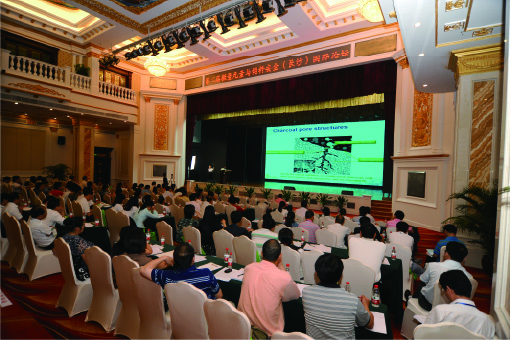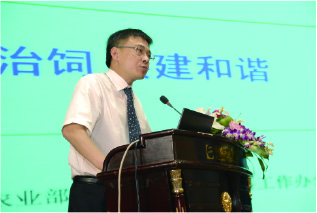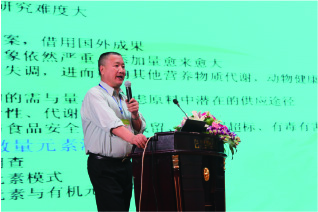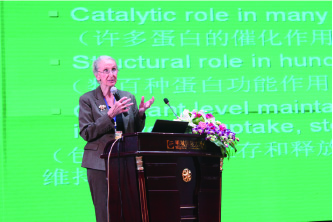Summary of Experts’ Presentation on the 2nd Trace Elements & Feed Safety (Changsha) International Forum

Though the two-day trace elements forum sponsored by Xingjia Bio-Engineering Co., Ltd is ended, the experts’ excellent lectures are still lingering. On the turning point of animal husbandry, periodically holding the forum on trace elements and food safety means the sponsor’s responsibility and the trend of walking towards science and advancement of the industry. During the communication with the guests in the meeting, we got the information that in fact, most of Chinese feed enterprises need to improve the application of trace elements, continuously change the cognition and using concept on trace elements, and further research on the utilization of novel trace elements, etc. We believe all of the issues can be solved only by cognition, discussion, referring and application. We need to select advantageous advanced concepts, and bravely face the reality we have.
To share the excellence of the forum with more feed enterprises, we specially select some experts’ classical points to share with more people engaging in animal husbandry, and herewith we also expect you to share your ideas on trace elements with us.

Mr. Wang Xiaohong, Director of the Feed Division of Animal Husbandry Dept.,Ministry of Agriculture: Revision Background of the Administrative Regulations on Feed and Feed Additives and the Policy Interpretation
In 2009 the feed production is 140 million tons, an increase of 2.4% year on year, and the output had been increased from 425.7 billion Yuan to 450 billion Yuan.
Current situation of feed quality safety:
The general safety factors on feed products: 6,937 random inspections were conducted in the year, and the pass rate is 90.9% (which is 89% and 88.6% in 2007 and 2008, respectively). Monitoring of illicit drugs in the feed at the link of breeding: A total of 3,062 random inspections were conducted in the whole year and testing was made for the illicit drugs including Clenbnterol Hydrochloride, Ractopamine, Salbutamol, Tonyred, Diazepam, etc. (Salbutamol was found for one time.) Monitoring of melamine in feed raw materials and feed products: 4,230
random inspections were conducted in animal albumen raw materials, milk cow raw materials and other feed products, and the detection rate is 0.66% (3.99% in 2008).
For the unqualified crude protein in mixed feed and concentrated feed: in 2009 the unqualified specimen exceeds 80%, which is 72.9% in 2008, 54.6% in 2007 and 76.9% in 2006.
For the counterfeiting of feed additives and additive premix: the content of choline chloride is less than 5% of the nominal value or is zero at all, and the contents of Cu and Zn in trace elements premix are in serious shortage.
The issues of illegal addition and excessive addition of additives: the issue of adding clenbnterol hydrochloride, the issue of use of melamine and other “falsely increased” protein substances, and the excessive use of Cu and Zn.
The issue of unqualified feed labels: in 2009 the pass rate is 82.8%, 83.2% in 2008, 88.1% in 2007, 86% in 2006 and 88.8% in 2005.
The pass rate of the distribution links is lower than that of the production links: the monitoring results of past years show the feed products pass rate of the distribution links is always lower than that of the production link.
Current situation of the industry:
The feed industry is at the stage of transition from becoming bigger into becoming stronger. The number of feed enterprises is large and at different levels, the management levels and the quality of employees are varied, and the protein feed raw materials are in shortage. Currently there are more than 12,000 feed enterprises in China, which are reduced by 2,000 each year. It is the result of fierce market competition on one hand, and on the other hand, it is due to the intensified supervision.
Revision of the Regulations:
The main works of the revision of the Regulations have been completed, the supporting rules are being revised and the revision of sanitary standards and label standards are being revised quickly. The major revisions include the following issues: subject of responsibility, raw materials control, full-course monitoring, product recall and legal responsibility.
The major changes of the Regulations and the supporting rules after the revision:
First, it makes clear that manufacturers and distributors operators are the first responsible person for the feed quality safety, and the responsibilities of local people’s government at and above county level in terms of the organization and leadership, mechanism perfection and conditions guarantee on feed safety are confirmed.
Second, it makes clear that the Ministry of Agriculture is responsible for making the Catalogue of Varieties of Feed Raw Materials and the Catalogue of Varieties of Feed Additives.
Third, it defines the system of establishing monitoring period for new feeds and feed additives and makes clear that the manufactures shall have the obligation of collecting relevant data about quality safety and reporting.
Forth, in terms of imported feed and feed additives, it presents the system requiring overseas enterprises to conduct necessary site inspection and requiring the implementation of effectiveness and safety test at designated agencies.
Fifth, it makes clear the full-course quality control obligation of the manufacturers, which requires enterprises to properly control the raw materials entering into plants, purchase and use the feeds and feed additives meeting the quality safety regulations, establish a purchase inspection and recording system, and requires manufacturers to carry out the production according to the Quality Safety Regulations on Production of Feeds and Feed Additives. Sixth, it perfects the management of non-feed substances, which are prohibited to be used in the production of feeds and feed additives; it is forbidden to distribute and use feeds and feed additives containing non-feed substances, nor to provide non-feed substances to the feed manufactures and feed users.
Seventh, it perfects the safety management at the links of distribution, requires the distributors of feeds and feed additives to get filed at the local feed management authorities, and it is forbidden to unpack, subpackage and processing feeds and feeds additives.
Eighth, it stipulates that the manufacturers and distributors shall report the quality safety problems actively and recall and stop the sales of products with problems.

Dr. Zhang Weijun, General Manager of Xingjia Bio-Engineering Co., Ltd: Research and Application of Trace Elements
The major content of the speech includes: brief introduction to trace elements, inorganic trace elements and organic trace elements.
Trace elements are the necessary nutrient substance for animals to live and produce products, which can not be synthetized within the body but must be supplied externally, and their major sources include feed raw materials and trace elements additives. The addition of such elements in animal feed is little, but it nearly participates in all physiological and biochemical metabolism of animal bodies whether directly or indirectly, and it is closely related with the growth and health of animals.
Zinc is an essential element for animal bodies: it participates in the formation of enzyme in bodies, regulates the immunity of animals, regulates the expression of growth axis and gene, promotes the increase of feed intake of animals and accelerates the wound healing, etc.
The commonly used inorganic zinc sources have the following problems: zinc sulfate are mostly produced by using zinc suboxides, some are even produced from Cu-Cd slag, thus residues of Cd are left excessively in the zinc sulfate, which are sometimes even up to more than 10%. In the process of production the potassium permanganates are often used as oxidants to remove impurities, which may bring residues in the final products and may cause the change of color of the mixing, and more seriously, the nutritional benefits of vitamins and enzyme will be affected.
The content of heavy metals in zinc oxide products is excessive and the utilization rate is low, and as a nutritional additive the supplement amount must be increased to meet the needs of animals, but it will affect the palatability of daily feeds, which is harmful for the coat color and health of the animals in later period, thus the animals can not grow well, and environmental pollution and resources waste will be caused.
The new type zinc source-basic zinc chloride (BZC) has the following advantages: good stability, difficult to be soluble in water and alkaline solution and partially soluble in acid solution; most of BZC enter into the intestinal canal in molecular state to play a role; aside from meeting the basic nutritional needs of animals, the dissociative zinc ions may also not be so excessive that the growth and coat color will be impacted. It has broad-spectrum antibacterial, astringing and absorbing actions, can astringe epithelial cells, reduce the permeability of intestinal mucosa and decrease the seepage of internal fluid of common cells, increase the dryness of animal dejecta, prolong the residence time of the dejecta in the intestinal canals and prevent diarrhea. It can participate in the metabolism of endocrine system, promote the secretion of growth hormone and improve the growth rate and metabolism rate of nutritional substances.
Organic acid salts including ferrous fumarate are the same as the inorganic

Dr. Gretchen Hill, Professor of University of Michigan: The Latest Progress of Research on Trace Elements of Cu and Zn
With the progress of technology, the understanding of people on inorganic trace elements is more and more deepening.
Zinc participates in metabolism extensively in animal bodies and plays a great role in the normal metabolism of bodies.
Sometimes the inorganic trace elements are also with side effects, and the organic trace elements are being concerned more than the past. Experiments show that the organic trace elements will play a greater role than the inorganic trace elements. A large majority of inorganic trace elements are with very low absorption rate in animal bodies, and generally more than 90% of them are excreted, while the absorption of zinc sulfates is only about 6%.
We can not separately view the metabolism of trace elements in bodies, because different trace elements have very close antagonism in bodies. Trace elements can only be absorbed with the formation of organic matters in animal bodies.
The metabolism of trace elements of poultries has very important influence on their next generation. Trace elements are also an important means of regulation in maintaining the high-yield of sows. The separate use of zinc will have the best result because more than 200 kinds of proteins in bodies are related with zinc, and the lack of zinc will soon bring about problems for the bodies.
The difference between organic copper and inorganic copper is: feeding the organic copper can regulate the CSS protein and the antioxidant factors in bodies will be increased significantly.

